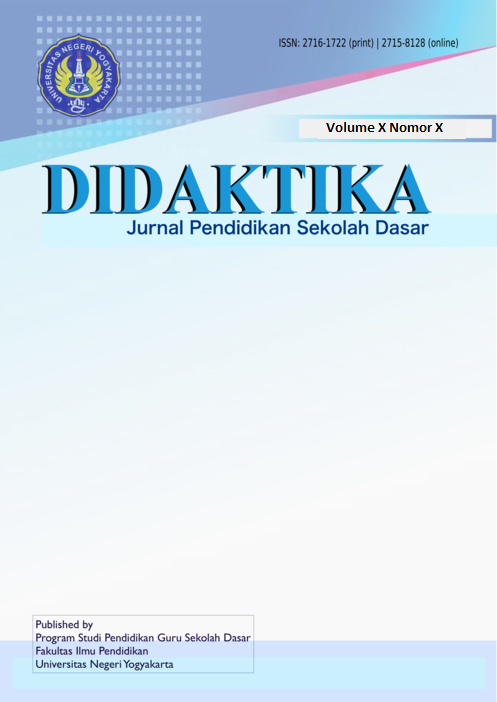Upaya meningkatkan Kemampuan Pemecahan Masalah melalui Model Problem Posing pada Mata Pelajaran Matematika
DOI:
https://doi.org/10.21831/didaktika.v2i1.28094Abstract
This research is motivated by the low problem solving ability of students in Mathematics in class V SDIT Nurut Taqwa West Cikarang. This study aims to improve the ability to solve Mathematical problems through Problem Posing learning models for fifth grade students at SDIT Nurut Taqwa Cikarang Barat. This research method uses Classroom Action Research (CAR) which consists of 3 cycles. Each cycle consists of stages of action planning, implementation of actions, stages of observation and assessment, then reflection. Subjects numbered 19 students. The data in this collection was obtained using data collection techniques in the form of written tests and observations. The criterion for success in this study is if 80% of the number of students reach the KKM value that has been set is 70. Based on the results of the study obtained in cycle I, the problem solving ability of students obtained a percentage of mastery learning by 32% with an average value of 58.95. In cycle II, the problem solving ability of students obtained a percentage of completeness of 63% with an average value of 74. In cycle III, the problem solving ability of students obtained a percentage of mastery learning by 89% with an average value of 85. The conclusion of this study is a model Problem Posing learning can improve Mathematical problem solving skills in fifth grade students at SDIT Nurut Taqwa Cikarang Barat.
References
Arikunto, S. dkk. (2015). Penelitian Tindakan Kelas. Jakarta: PT Bumi Aksara.
Hadi, Sutarto. (2014). "Metode Pemecahan Masalah Menurut Polya Untuk Mengembangkan Kemampuan Siswa Dalam Pemecahan Masalah Matematis Di Sekolah Menengah Pertama". Jurnal Pendidikan Matematika, Volume 2, Nomor 1, Februari 2014 , hlm 53-61. [Online]. Tersedia Diunduh Pada 10 April 2018.
Mawaddah, Anisah. (2015). "Kemampuan Pemecahan Masalah Matematis Siswa Pada Pembelajaran Matematika Dengan Menggunakan Model Pembelajaran Generatif (Generative Learning) Di SMP". Jurnal Pendidikan Matematika, Volume 3, Nomor 2, Oktober 2015, hlm 166-175. [Online]. Tersedia Diunduh pada 4 April 2018.
Mubarokah, Ikfi. (2014). "Upaya Meningkatkan Kemampuan Pemecahan Masalah Matematika Siswa Dengan Model Experiental Learning". [Online]. Tersedia Diunduh Pada 23 Mei 2018.
Sari, Rike. (2016). Penerapan Model Pembelajaran Problem Posing Untuk Meningkatkan Hasil Belajar Matematika Siswa Kelas VA SD Negeri 1 SIDODADI. [Online]. Tersedia Diunduh Pada 16 Mei 2018.
Soemarmo, Utari. (2014). Penilaian Pembelajaran Matematika. Bandung: PT Refika Aditama.
Shoimin, Aris. (2014). 68 Model Pembelajaran Inovatif dalam Kurikulum 2013. Yogyakarta: Ar- Ruzz Media.
Syafri, Fatrima Santri, M.Pd. (2016). Pembelajaran Matematika.Yogyakarta: Matematika.
Downloads
Published
How to Cite
Issue
Section
Citation Check
License
- Authors retain copyright and grant the journal right of first publication with the work simultaneously licensed under a Creative Commons Attribution License that allows others to share the work with an acknowledgement of the work's authorship and initial publication in this journal.
- Authors are able to enter into separate, additional contractual arrangements for the non-exclusive distribution of the journal's published version of the work (e.g., post it to an institutional repository or publish it in a book), with an acknowledgement of its initial publication in this journal.
- Authors are permitted and encouraged to post their work online (e.g., in institutional repositories or on their website) prior to and during the submission process, as it can lead to productive exchanges, as well as earlier and greater citation of published work.






